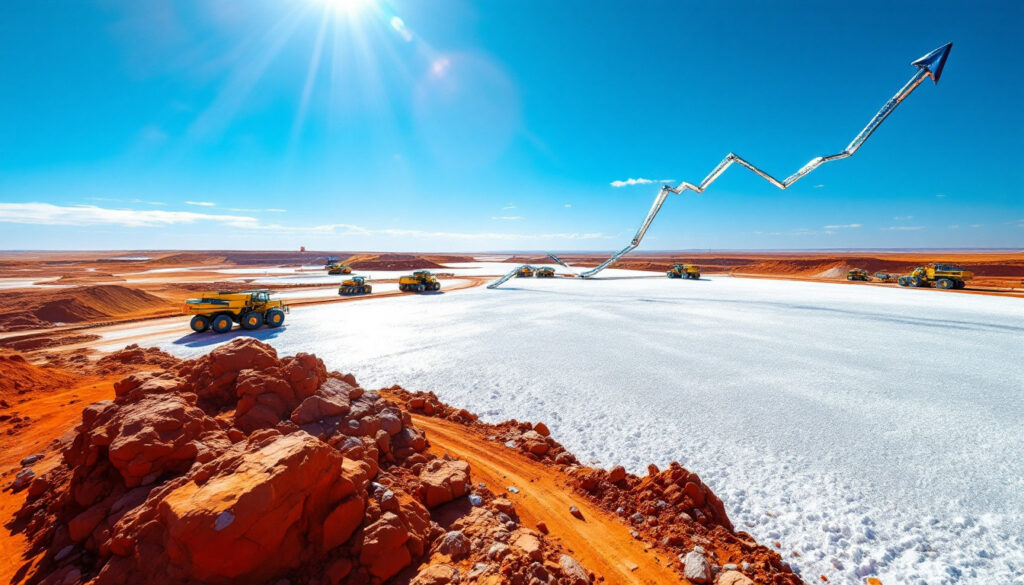WA Government's Lithium Industry Loan Facility: Strategic Support for Critical Minerals
The Western Australian government has established a $50 million Lithium Industry Loan Facility as part of a broader $150 million support package designed to sustain the state's crucial lithium sector during market downturns. This initiative, introduced in January 2025, specifically targets lithium producers facing operational challenges due to prices falling below $US1,100 per tonne, highlighting the government's recognition of lithium's strategic importance to both regional economies and global supply chains.
The facility represents a targeted approach to maintaining production capacity during cyclical downturns, with eligibility criteria focused on operational producers demonstrating financial viability but requiring temporary assistance. Companies must show clear paths to sustainability once market conditions improve, ensuring the support acts as a bridge rather than a permanent subsidy.
"The WA Government's proactive support demonstrates its understanding of the lithium industry's cyclical nature and commitment to maintaining Australia's position in global critical minerals supply chains," noted Tony Ottaviano, Liontown Resources' Managing Director.
Unlike previous resource sector support mechanisms that often came with complex conditions, this facility offers straightforward terms designed to provide immediate relief while protecting taxpayer interests. The unsecured nature of these loans means minimal administrative burden for qualifying companies, allowing them to focus on operational improvements rather than compliance.
Strategic importance factors include:
- Preservation of Western Australia's 50% global market share in lithium spodumene production
- Maintenance of technical expertise and skilled workforce within the region
- Protection of supply chain security for battery manufacturers and automakers worldwide
- Positioning Australia advantageously for the projected 300% increase in lithium demand by 2030
The facility also integrates with federal critical minerals strategy, creating a multi-level support framework designed to weather temporary market disruptions while strengthening long-term competitiveness.
How Liontown's $15 Million Loan Agreement Works
Liontown Resources has secured a $15 million loan under the WA government's Lithium Industry Loan Facility, structured with carefully designed terms to provide immediate relief while ensuring taxpayer protection. This interest-free arrangement includes a repayment schedule of quarterly installments over a two-year period, beginning after the interest-free period concludes.
The loan's interest-free status is maintained until either of two conditions is met: lithium prices exceed $US1,100 per tonne for two consecutive quarters, or the calendar reaches June 2026. This price-based trigger mechanism creates a dynamic repayment structure aligned with market recovery, rather than arbitrary deadlines that might not reflect industry conditions.
Key Financial Terms and Conditions
- Zero interest charges during the support period (until price recovery or June 2026)
- Unsecured status, requiring no collateral or assets pledged against the loan
- No impact on Liontown's existing debt facilities with commercial lenders
- Funds disbursement scheduled within the June 2025 quarter
- No prepayment penalties if market conditions improve ahead of projections
Financial analysts highlight that the loan's structure provides approximately $900,000 in interest savings annually (based on prevailing commercial rates), significantly improving Liontown's cash position during this challenging period.
"The flexible trigger conditions align with market recovery projections and demonstrate the government's sophisticated understanding of commodity cycles," noted a resources analyst from UBS.
Importantly, the loan terms protect taxpayers by ensuring automatic conversion to standard commercial terms once the lithium market recovers, preventing companies from receiving unnecessary subsidies during profitable periods.
Additional Support Measures Secured by Liontown
Beyond the $15 million loan, Liontown Resources has secured complementary support measures designed to reduce operational costs during the market downturn. These additional elements create a comprehensive assistance package addressing multiple financial pressure points.
Port Charges Waiver Benefits
The waiver of port charges represents a significant operational cost reduction for Liontown, as the company typically ships substantial volumes through Western Australian ports. This waiver:
- Eliminates handling and wharfage fees for lithium concentrate exports
- Reduces logistics costs by approximately 8-10% per shipment
- Applies retroactively from January 2025
- Continues until either the two-year period concludes or lithium prices exceed the specified threshold
Mining Tenement Fee Rebates
The mining tenement fee rebates provide additional financial relief by:
- Returning 75% of annual tenement maintenance fees for producing operations
- Applying to mining leases currently in production phases
- Excluding exploration tenements to focus support on actual producers
- Representing approximately $1.2 million in annual savings for Liontown
These combined measures create an estimated $3.5 million annual benefit beyond the loan facility, according to industry analysts. This multi-faceted approach addresses both capital needs and ongoing operational costs.
When compared to support offered to other lithium producers, Liontown's package appears consistent with broader industry assistance, though tailored to the specific operational profile of the Kathleen Valley project. Similar port charge waivers have been extended to qualifying producers like Mineral Resources and Pilbara Minerals, ensuring equitable support across the sector.
Why Government Support Is Critical for the Lithium Sector
The Western Australian lithium sector faces unprecedented market challenges, with prices having fallen approximately 60% from their 2023 peaks. This dramatic decline threatens the operational viability of even the most efficient producers, making government intervention a strategic necessity rather than optional assistance.
Market Volatility Impact Analysis
The lithium market's extreme price volatility stems from multiple factors:
- Rapid expansion of production capacity in response to earlier high prices
- Unexpected softening of EV demand growth in major markets
- New production from African lithium mines creating temporary oversupply
- Speculative trading amplifying natural market cycles
These combined forces have driven spodumene concentrate prices below $US800 per tonne in some transactions, well below the sustainable production costs for many Western Australian operations. This threatens not just individual companies but the entire supply chain infrastructure and technical capabilities built over the past decade.
Economic significance metrics:
| Metric | Value |
|---|---|
| WA's lithium sector economic contribution | $23 billion annually |
| Direct employment | Approximately 15,000 jobs |
| Indirect employment | Estimated 45,000 additional jobs |
| Regional communities dependent on sector | 12 major communities |
| Global market share | 50% of lithium spodumene production |
"Maintaining domestic production capacity during cyclical downturns is vital not just for immediate economic reasons, but for Australia's strategic positioning in energy transition supply chains," emphasized Western Australia's Resources Minister.
Industry analysts note that unlike previous mining downturns, the lithium sector faces the added complexity of geopolitical competition, with the United States, European Union, and China all actively securing lithium supply through various policy mechanisms. Without support, Australia risks permanent loss of market share despite having superior resources and environmental practices.
Kathleen Valley Project Performance and Outlook
Liontown's flagship Kathleen Valley project has demonstrated impressive operational resilience despite challenging market conditions. The operation produced 95,709 dry metric tonnes of spodumene concentrate in the March quarter, representing a robust 12% increase compared to the December quarter. This production growth trajectory indicates the project's strong fundamentals and operational execution.
Operational Improvements and Efficiency Gains
The company has implemented several key initiatives driving performance improvements:
- Automated ore sorting technology reducing waste rock processing by 22%
- Optimized crushing circuits increasing throughput by 15%
- Enhanced recovery rates through reagent optimization
- Preventative maintenance program reducing unplanned downtime by 33%
These operational enhancements have contributed to an 8% reduction in unit production costs, partially offsetting the impact of lower market prices and demonstrating management's focus on controllable variables despite external market pressures.
"Kathleen Valley is progressing exceptionally well on its production ramp-up curve, with performance metrics consistently exceeding our internal forecasts for this stage of development," stated Tony Ottaviano, Liontown's Managing Director.
Development Timeline and Expansion Plans
The project maintains its strategic development schedule despite market headwinds:
- Phase 1 (Current): 3 million tonnes per annum (Mtpa) processing capacity
- Phase 2 (2026-2027): Expansion to 4 Mtpa
- Phase 3 (2028-2029): Final expansion to 5 Mtpa
This measured approach allows Liontown to align capacity growth with projected market recovery while maintaining capital discipline. The government support package plays a crucial role in maintaining this development momentum, preventing the project delays that have historically plagued resource projects during downturns.
Australia's Critical Minerals Strategy: Broader Implications
The WA government's support for Liontown Resources signals a deeper commitment to domestic lithium supply chain resilience that extends beyond temporary market interventions. This approach positions Australia strategically in the increasingly competitive global battery materials landscape, where nations are actively securing access to critical minerals through various policy mechanisms.
International Comparison: Support Mechanisms Worldwide
Australia's approach differs significantly from international counterparts:
| Country | Support Mechanism | Key Features |
|---|---|---|
| United States | Inflation Reduction Act | Tax credits for domestic content; direct loans |
| European Union | Critical Raw Materials Act | Streamlined permitting; strategic stockpiles |
| Canada | Critical Minerals Infrastructure Fund | Co-funding for processing facilities |
| China | Strategic Stockpiling | Government-backed purchasing during downturns |
| Australia | WA Lithium Support Package | Targeted loans; fee rebates; maintained production |
The WA approach balances immediate needs with long-term strategic positioning, avoiding both the massive subsidies seen in some jurisdictions and the purely market-driven approach that risks permanent capacity loss.
Australia's strategy recognizes that with 55% of global lithium reserves, the country has a natural advantage that needs protection during temporary market disruptions. The support package ensures these geological advantages translate to sustained economic benefits rather than being compromised by short-term market fluctuations.
"Australia risks losing market share without sustained investment in production capacity and downstream processing, despite holding superior resources," warns a senior analyst from Wood Mackenzie.
The government support also aligns with the federal Critical Minerals Strategy, creating complementary layers of assistance that maintain immediate production while encouraging development of more sophisticated battery-grade lithium refining capabilities—positioning Australia higher in the value chain for future market cycles.
FAQ: Western Australia's Lithium Industry Support
How does the lithium price threshold mechanism work?
The price threshold mechanism uses a two-quarter verification system to ensure sustained recovery before support measures end. Specifically, the average lithium spodumene concentrate price must exceed $US1,100 per tonne for two consecutive quarters, as measured by recognized industry benchmarks including Fastmarkets and Asian Metal indices. This approach prevents premature termination of support based on temporary price spikes that might not represent true market recovery.
What happens if lithium prices remain below $US1,100 per tonne?
If prices remain below the threshold, Liontown will continue to benefit from the interest-free period until June 2026, at which point the loan converts to standard commercial terms regardless of market conditions. The port charges waiver and tenement fee rebates similarly continue for the full two-year period in this scenario. This creates a predictable support timeframe that balances company needs with taxpayer protection.
Are other lithium producers eligible for similar support?
Yes, all Western Australian lithium producers meeting the eligibility criteria can apply for similar support measures. The program is industry-wide rather than company-specific, with applications evaluated based on:
- Current production status (operating mines prioritized)
- Demonstrated financial viability pre-downturn
- Clear path to sustainability post-support
- Strategic importance to domestic supply chains
- Potential economic impact if operations cease
Companies including Mineral Resources and Pilbara Minerals have reportedly engaged with the government regarding similar arrangements, though specific details remain confidential.
How does this support compare to other mining sector assistance programs?
This lithium support package differs from previous mining assistance programs in several key aspects:
- Targeted scope: Focused specifically on lithium rather than broad minerals sector
- Temporary design: Clear exit mechanisms tied to market recovery
- Operational focus: Prioritizes maintaining production over exploration
- Self-liquidating: Support automatically terminates upon price recovery
- Strategic alignment: Connected to broader critical minerals policies
Unlike previous programs that sometimes created ongoing dependencies, this package explicitly aims to bridge temporary market disruptions rather than subsidize fundamentally uneconomic operations.
Expert Insights: The Future of WA's Lithium Industry
Market analysts offer varied perspectives on the effectiveness of government intervention in the lithium sector, though most acknowledge the strategic rationale behind the support package. The consensus view suggests that while the assistance provides necessary short-term relief, the industry's long-term health depends on fundamental demand growth and market rebalancing.
Effectiveness of Government Intervention
"Government support stabilizes the sector during this downturn, but long-term viability ultimately requires price recovery driven by EV adoption rates," notes a UBS resources analyst. "The intervention buys time, but doesn't change underlying market fundamentals."
Industry stakeholders have generally responded positively, with the Chamber of Minerals and Energy of Western Australia calling the package "appropriately calibrated to maintain critical capacity without distorting market signals." Environmental groups have expressed mixed views, acknowledging the need for domestic supply chains for energy transition while questioning the sustainability implications of continued expansion.
Long-term Outlook for Lithium Demand
Experts project global lithium demand to grow approximately 20% annually through 2030, driven by:
- Electric vehicle sales growth across all major markets
- Energy storage deployments for grid stabilization
- Diversification of battery chemistries still requiring lithium
- Industrial applications beyond the energy sector
This growth trajectory suggests current oversupply conditions will eventually correct, though timing remains uncertain. Most analysts project meaningful price recovery beginning in late 2026, with potential supply deficits emerging by 2028 as major automakers accelerate electrification plans.
The strategic positioning of Australian producers in global supply chains remains strong despite current challenges, with several competitive advantages:
- Superior resource quality with lower impurity levels
- Established infrastructure and skilled workforce
- Political stability compared to alternative sources
- Strong environmental and social governance frameworks
- Proximity to major Asian processing hubs
"The current market correction, while painful, will ultimately strengthen the industry by eliminating marginal projects and focusing investment on truly world-class assets like those in Western Australia," explains a senior industry consultant from The Australian Financial Review.
The government support helps ensure that when markets inevitably recover, Western Australian producers will be positioned to rapidly respond to renewed demand rather than requiring years of rebuild and recommissioning efforts. Furthermore, these measures complement other initiatives like lithium industry tax breaks and support for projects like Thacker Pass lithium production that collectively strengthen the global critical minerals supply chain.
Want to Stay Ahead of ASX Mining Discoveries?
Discovery Alert's proprietary Discovery IQ model provides instant notifications when significant mineral discoveries are announced on the ASX, giving investors a crucial market edge. Explore how historic discoveries have generated substantial returns by visiting the Discovery Alert discoveries page and begin your 30-day free trial today.




